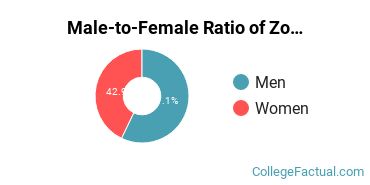 by our College Data Analytics Team
by our College Data Analytics TeamZoology is a major offered under the biological and biomedical sciences program of study at Colorado State University - Fort Collins. Here, you’ll find out more about the major doctor’s degree program in zoology, including such details as the number of graduates, ethnicity of students, related majors and concentrations, and more.
If there’s something special you’re looking for, you can use one of the links below to find it:
During the 2019-2020 academic year, part-time graduate students at Colorado State paid an average of $1,433 per credit hour if they came to the school from out-of-state. In-state students paid a discounted rate of $584 per credit hour. The following table shows the average full-time tuition and fees for graduate student.
| In State | Out of State | |
|---|---|---|
| Tuition | $10,520 | $25,791 |
| Fees | $2,264 | $2,264 |
Colorado State does not offer an online option for its zoology doctor’s degree program at this time. To see if the school offers distance learning options in other areas, visit the Colorado State Online Learning page.
Women made up around 42.9% of the zoology students who took home a doctor’s degree in 2019-2020. This is less than the nationwide number of 51.8%.

None of the zoology doctor’s degree recipients at Colorado State in 2019-2020 were awarded to racial-ethnic minorities*.

| Race/Ethnicity | Number of Students |
|---|---|
| Asian | 0 |
| Black or African American | 0 |
| Hispanic or Latino | 0 |
| Native American or Alaska Native | 0 |
| Native Hawaiian or Pacific Islander | 0 |
| White | 5 |
| International Students | 2 |
| Other Races/Ethnicities | 0 |
Zoology students may decide to major in one of the following focus areas.
| Focus Area | Annual Graduates |
|---|---|
| Zoology/Animal Biology | 1 |
| Wildlife Biology | 6 |
You may also be interested in one of these majors related to zoology.
| Related Major | Annual Graduates |
|---|---|
| General Biology | 3 |
| Biochemistry, Biophysics & Molecular Biology | 9 |
| Botany/Plant Biology | 2 |
| Cell Biology & Anatomical Sciences | 13 |
| Microbiological Sciences & Immunology | 5 |
*The racial-ethnic minorities count is calculated by taking the total number of students and subtracting white students, international students, and students whose race/ethnicity was unknown. This number is then divided by the total number of students at the school to obtain the racial-ethnic minorities percentage.
More about our data sources and methodologies.